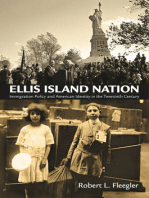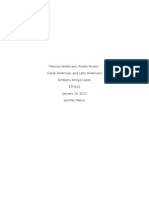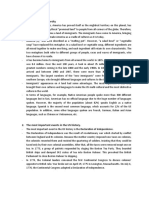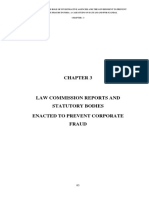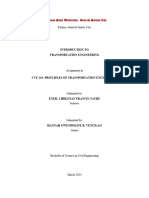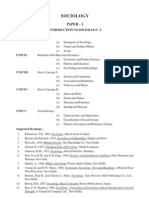văn-hóa-mĩ
văn-hóa-mĩ
Uploaded by
Nguyen Bao Chau TranCopyright:
Available Formats
văn-hóa-mĩ
văn-hóa-mĩ
Uploaded by
Nguyen Bao Chau TranCopyright
Available Formats
Share this document
Did you find this document useful?
Is this content inappropriate?
Copyright:
Available Formats
văn-hóa-mĩ
văn-hóa-mĩ
Uploaded by
Nguyen Bao Chau TranCopyright:
Available Formats
Chia 26 ý thành 4 chủ đề lớn để dễ trình bày:
1. Đa dạng dân số và văn hóa (Ý 1-10)
2. Nhập cư và thay đổi dân số (Ý 11-14)
3. Đa nguyên văn hóa và bản sắc dân tộc (Ý 15-20)
4. Giá trị và niềm tin truyền thống (Ý 21-26)
I. Population and cultural diversity.
1. The immense size of the United States.
-The United States is large, spanning many time zones and climates.
-This leads to diversity in lifestyle and culture within the country.
2. Its great ethnic diversity.
-Except for the native-born, all Americans are descendants of immigrants.
-This ethnic mix has created a unique American culture.
3. The "Melting Pot" and the Meaning of Cultural Pluralism.
The melting pot is a hidden permission for the combination of many cultures,
languages and religions to create an independent national identity for core
Americanism. On the other hand, American nationalism contains racist motives
within itself that make the melting pot cultural assimilation.
In 1815, the population of the United States was 8.4 million. Over the next 100
years, the country took in about 35 million immigrants, with the greatest
numbers coming in the late 1800s and the early1900s. Many of these new
immigrants were not from northern Europe. In 1882, 40,000 Chinese arrived,
and between 1900 and 1907 there were more than 30,000 Japanese immigrants.
But by far the largest numbers of the new immigrants were from central,
eastern, and southern Europe. The new immigrants brought different languages
and different cultures to the, United States, but gradually most of them
assimilated to the dominant American culture they found her
However, diversity has changed American culture over time.
II. Population and cultural diversity
1. History of immigration and immigration control laws.
Immigration laws have changed over time, from open immigration in the 19th
century to strict controls in the 20th century.
2. Growth of immigration from Asia and Latin America.
Two things are certain: The dominant American culture has survived, and it has
more or less successfully absorbed vast resulted in large numbers of non
numbers of immigrants at various points in its history. It has also been changed
over time by all the immigrant groups who 1900s, 90 percent of all immigrants
have settled here.
III. Cultural pluralism and national identity
1. The role of cultural pluralism.
Historically, although the children of immigrants may have grown up bilingual
and bicultural, for a number of reasons many did not pass on their language and
culture. Thus, many grandchildren of immigrants do not speak the language of
the old country and are simply American by culture. However, in parts of the
country with established communities that share a common language or
culture,
bilingualism6 and biculturalism continue.
2. Harmony and change in national identity.
On the one hand, many Americans try to maintain their ethnic heritage and
their cultural traditions. On the other hand, the number of interracial marriages
is increasing, and the majority of young people believe it does not matter which
race or ethnic group they marry into. Evidence of this racial acceptance was the
2008 election of Barack Obama, the first African-American president.
President Obama is actually bi-racial, the son of a white mother and a black
father, a native of Kenya. His ethnic heritage8 includes an Irish great, great,
great grandfather who immigrated to the United States in 1850.
In spite of all this diversity, there is still a tie that binds Americans together.
That tie is a sense of national identity-of being an American. Incidentally, when
citizens of the United States refer to themselves as Americans, they have no
intention of excluding people from Canada or Latin American countries as
residents of the American continents. There is no term such as United
Statesians in the English language, so people call themselves Americans. Thus,
what is really a language problem has sometimes caused misunderstandings.
IV. Traditional values and beliefs
1. Traditional American values: freedom, self-reliance, opportunity.
It is important to know that today there is much talk about American values and
what they really are. Much of the debate is over moral, or religious values. In
this book we are not discussing moral values. Instead, we are describing
cultural values-the cultural engine of the country. These cultural values have
defined the United States and caused people from all over the world to embrace
the way of life here and eventually to identify themselves as "Americans."
Indeed, by the third generation here, most immigrants have lost the language
and culture of their grandparents and they think of themselves as just plain
"Americans."
2. The influence of Alexis de Tocqueville in recognizing these values.
Throughout this book we will be drawing on the wisdom of a famous observer
of the American scene, Alexis de Tocqueville. Tocqueville came to the United
States as a young Frenchman in 1831 to study the American form of
democracy and what it might mean to the rest of the world. After a visit of only
nine months, he wrote a remarkable book called Democracy in America, which
is a classic study. of the American way of life. Tocqueville had unusual powers
of observation. He described not only the democratic system of government
and how it operated, but also its effect on how Americans think, feel, and act.
Many scholars believe that he had a deeper understanding of traditional
American beliefs and values than anyone else who has written about the United
States. What is so remarkable is that many of these traits of the American
character, which he observed nearly 200 years ago, are still visible and
meaningful today.
V. Conclution
1. Population and Cultural Diversity:
The United States is a vast country with a wide range of ethnicities, cultures,
and climates. From its origins as a “melting pot,” the country has evolved into a
multicultural society where communities maintain their own identities while
integrating into a common culture.
2. Immigration and Population Change:
Immigration plays a significant role in shaping the U.S. population. From
historic waves of immigration to the rise of immigrants from Latin America
and Asia, the United States has become increasingly diverse in culture and
ethnicity.
3. Cultural Diversity and National Identity:
Despite ethnic and cultural differences, Americans are united by a common
ethnicity and values such as self-employment, opportunity, and self-reliance.
This is what keeps American society connected and growing.
4. Traditional Values and Beliefs: Value systems such as individualism, hard
work, and the “American Dream” not only attracted immigrants but also
shaped American culture and society. These values continue to be the
foundation that drives the nation’s development.
You might also like
- The Voice of Babaji and Mysticism Unlocked PDFDocument2 pagesThe Voice of Babaji and Mysticism Unlocked PDFsanthiyasantthosh100% (1)
- Culture and Customs of The Sioux Indians (2011) BBS PDFDocument215 pagesCulture and Customs of The Sioux Indians (2011) BBS PDFGeorge Kwamina AnamanNo ratings yet
- List of Candidates Applied For The Post of Junior Clerk Bs-11Document78 pagesList of Candidates Applied For The Post of Junior Clerk Bs-11waseemaslam_education100% (1)
- Ametican Studies 1Document12 pagesAmetican Studies 121128232No ratings yet
- American LecturesDocument149 pagesAmerican LecturesThảo TrầnNo ratings yet
- Melting Pot or Salad BowlDocument22 pagesMelting Pot or Salad Bowlvolo1234bookNo ratings yet
- American StudiesDocument14 pagesAmerican Studiesfatmesalimova2No ratings yet
- Dominant American Culture PatternsDocument15 pagesDominant American Culture PatternsInsania Fadhalula100% (2)
- The Changing Racial and Ethnic Composition of TheDocument19 pagesThe Changing Racial and Ethnic Composition of TheHani MansouriNo ratings yet
- Rudy Acuna - Assimilation Total SurrenderDocument10 pagesRudy Acuna - Assimilation Total SurrenderEditorNo ratings yet
- American ways срезDocument6 pagesAmerican ways срезnerrnrnNo ratings yet
- Ellis Island Nation: Immigration Policy and American Identity in the Twentieth CenturyFrom EverandEllis Island Nation: Immigration Policy and American Identity in the Twentieth CenturyNo ratings yet
- Melting or Salad Bowl: So Which Model Is Better?Document2 pagesMelting or Salad Bowl: So Which Model Is Better?Khánh NguyễnNo ratings yet
- 50 Questions CultureDocument6 pages50 Questions CultureSWEET COLORSNo ratings yet
- Native AmericansDocument2 pagesNative AmericansmiddletonstudentNo ratings yet
- American PopulationDocument7 pagesAmerican PopulationjorisNo ratings yet
- American Culture 1 - Unit 1 - Immigration and Diversity in The United StatesDocument27 pagesAmerican Culture 1 - Unit 1 - Immigration and Diversity in The United StatesThâm Nguyễn ThịNo ratings yet
- Definition of Culture TranscritoDocument6 pagesDefinition of Culture TranscritoJessy QueenNo ratings yet
- Van Hoa MyDocument60 pagesVan Hoa Mythanhduom100% (1)
- Câu 1. The US Culture Diversity?: 1. American RevolutionDocument8 pagesCâu 1. The US Culture Diversity?: 1. American RevolutionLe Giang100% (1)
- AssimilationDocument25 pagesAssimilationNam NguyễnNo ratings yet
- Chapters 1 & 2 American WaysDocument88 pagesChapters 1 & 2 American WaysMỹ Tiên LêNo ratings yet
- ABDocument13 pagesABjameswuNo ratings yet
- Resumen 2º Cuatrimestre. American CivilizationDocument39 pagesResumen 2º Cuatrimestre. American CivilizationinmorichiNo ratings yet
- American Definition EssayDocument2 pagesAmerican Definition EssayDenise Nicole100% (1)
- Journal EntryDocument6 pagesJournal Entrycleon77No ratings yet
- Hispanic Immigration Threatens To Divide America PDFDocument4 pagesHispanic Immigration Threatens To Divide America PDFpiperezNo ratings yet
- Eth125 7Document9 pagesEth125 7Kchanchef89No ratings yet
- Material for Midterm 2 (Копия)Document9 pagesMaterial for Midterm 2 (Копия)rrhxk2zqwfNo ratings yet
- Introduction: Understanding The Culture of The United StatesDocument25 pagesIntroduction: Understanding The Culture of The United States강민서No ratings yet
- Internet Notes - Identity of Immigrants.Document19 pagesInternet Notes - Identity of Immigrants.Aisha RahatNo ratings yet
- The US Cultural DiversityDocument4 pagesThe US Cultural DiversityPhạm Ngọc MaiNo ratings yet
- Hispanic AmericansDocument6 pagesHispanic Americansgantts081906100% (2)
- 40-american-culture-1Document65 pages40-american-culture-1zoiubh123No ratings yet
- What Are The Most Spoken Languages in The U.S.Document3 pagesWhat Are The Most Spoken Languages in The U.S.lorenzo mahecha villaNo ratings yet
- Last Session of The AxisDocument11 pagesLast Session of The AxisJihen Ben SlimaNo ratings yet
- Group 2 - Weekly SummaryDocument13 pagesGroup 2 - Weekly SummaryFadilah KamilahNo ratings yet
- US History DiscussionDocument3 pagesUS History DiscussionitsqualitypapersNo ratings yet
- American CivilisationDocument4 pagesAmerican Civilisationseraphine0973No ratings yet
- Latino Americans G2docxDocument11 pagesLatino Americans G2docxMyyne 30No ratings yet
- Unit 2-Diversity - Traditions and CulturesDocument61 pagesUnit 2-Diversity - Traditions and Culturese7050000778No ratings yet
- America Is Melting Pot or Mixing BowelDocument6 pagesAmerica Is Melting Pot or Mixing BowelJahangir SoomroNo ratings yet
- DIDACTIC UNIT USA - GEOGRAPHY, FACTS & FIGURES - With AnswersDocument8 pagesDIDACTIC UNIT USA - GEOGRAPHY, FACTS & FIGURES - With AnswersNuria AguirreNo ratings yet
- TEMA 03 - Época ColonialDocument3 pagesTEMA 03 - Época Colonialnobas439No ratings yet
- Rudy Acuna - Los Primeros - Who Are We and What Do We Owe The PastDocument12 pagesRudy Acuna - Los Primeros - Who Are We and What Do We Owe The PastEditorNo ratings yet
- Latin FinalDocument12 pagesLatin Finalapi-273247415No ratings yet
- New Communities, 1960s-PresentDocument5 pagesNew Communities, 1960s-PresentAbdul Sattar Shah KhattakNo ratings yet
- Portfolio - NizuniroDocument22 pagesPortfolio - NizuniroNox340% (1)
- VACC86N20HOCC81A20MYCC83Document16 pagesVACC86N20HOCC81A20MYCC83hothihang04091993No ratings yet
- Study Materials - The 2nd Revision Test ACCDocument43 pagesStudy Materials - The 2nd Revision Test ACCLARA DÍEZ GONZÁLEZNo ratings yet
- Huntington The Hispanic Challenge-1 PDFDocument17 pagesHuntington The Hispanic Challenge-1 PDFShatabdiDasNo ratings yet
- Culture of The United StatesDocument16 pagesCulture of The United StateszouadraNo ratings yet
- ЛінгвоDocument108 pagesЛінгвоКатерина ЛуцівNo ratings yet
- Bilinguilism in American SchoolsDocument11 pagesBilinguilism in American SchoolsAnãyiss BatoūlNo ratings yet
- Us CultureDocument7 pagesUs Culturethicamthu655No ratings yet
- Where American people come from (1)Document17 pagesWhere American people come from (1)Rocio FerreiraNo ratings yet
- Us and Uk As Melting PotDocument11 pagesUs and Uk As Melting PotEnoc LòpezNo ratings yet
- Product Dissection For PAYTMDocument7 pagesProduct Dissection For PAYTMashikal70No ratings yet
- Footsteps 3 Grammar Practice Unit 4Document4 pagesFootsteps 3 Grammar Practice Unit 4Ana KaštelanacNo ratings yet
- 10 - Chapter 3 - Corporate FraudDocument28 pages10 - Chapter 3 - Corporate FraudAbhishek RajNo ratings yet
- Transportation EngineeringDocument13 pagesTransportation EngineeringHannah Gwendoline VencilaoNo ratings yet
- Cause & Effect 2Document3 pagesCause & Effect 2Ratih KuswidyasariNo ratings yet
- I. Dùng NEVER viết lại câu với hình thức đảo ngữDocument13 pagesI. Dùng NEVER viết lại câu với hình thức đảo ngữThanh Na LêNo ratings yet
- My Little Pony: Friendship Is Magic #2 (Of 4) PreviewDocument9 pagesMy Little Pony: Friendship Is Magic #2 (Of 4) PreviewGraphic Policy75% (8)
- The Concept of NegotiationDocument18 pagesThe Concept of NegotiationSabrina-MariaCatrinaNo ratings yet
- HafizDocument143 pagesHafizgarybediNo ratings yet
- Certificate of Appearance: Metrobank Mtap Deped Math Challenge Division FinalsDocument6 pagesCertificate of Appearance: Metrobank Mtap Deped Math Challenge Division FinalsPrince Genesis G. Gunhuran100% (1)
- 11 SociologyDocument13 pages11 SociologyMalsawmkima Maski-a100% (5)
- Manba Finance Closing LetterDocument2 pagesManba Finance Closing LetterRudhvi67% (3)
- Statement_XXXXXXXXXX3 (4)_unlockedDocument5 pagesStatement_XXXXXXXXXX3 (4)_unlockedmcushivam007No ratings yet
- Packaging Material Manufacturer Vendor Qualification QuestionnaireDocument17 pagesPackaging Material Manufacturer Vendor Qualification QuestionnaireDdivya KumarNo ratings yet
- 23MB103 AFM QP PG Nov-Dec 2024Document14 pages23MB103 AFM QP PG Nov-Dec 2024gnanaprakasamcNo ratings yet
- The Components of Customer ServiceDocument15 pagesThe Components of Customer ServiceOmid XademNo ratings yet
- Jiri Cejka, Senior Manager, Dipl - El.-Ing, CISADocument40 pagesJiri Cejka, Senior Manager, Dipl - El.-Ing, CISApreeti singhNo ratings yet
- Sanjay Industries Ltd. Balance Sheet and Income StatementDocument5 pagesSanjay Industries Ltd. Balance Sheet and Income Statementramki073033No ratings yet
- EF - English Vocabulary Pocket GuideDocument38 pagesEF - English Vocabulary Pocket GuideEdson Ribeiro100% (2)
- How To Crack The Cabin Crew Interview Cabin Crew CareerDocument1 pageHow To Crack The Cabin Crew Interview Cabin Crew CareerKajal MalviyaNo ratings yet
- Ignorant Cognition: Selene ArfiniDocument197 pagesIgnorant Cognition: Selene ArfiniJorge Ranz Clemente100% (1)
- The Life and Works of Rizal: Rowena S. Fillomena InstructorDocument42 pagesThe Life and Works of Rizal: Rowena S. Fillomena InstructorJellie An TalattagNo ratings yet
- When I Wear My Alligator Boots Narco-CultureDocument2 pagesWhen I Wear My Alligator Boots Narco-CulturejoaoNo ratings yet
- A2 Land Application FormDocument5 pagesA2 Land Application FormDephine dzomaNo ratings yet
- Difference Between Financial & Managerial AccountingDocument3 pagesDifference Between Financial & Managerial AccountingAnisa LabibaNo ratings yet
- Beedi Industry in KeralaDocument50 pagesBeedi Industry in KeralaAsh1ScribdNo ratings yet
- Disclaimer: Reproduction of This Document Is Allowed SubjectDocument9 pagesDisclaimer: Reproduction of This Document Is Allowed SubjectLawson Soh0% (1)
- Brazil Speech To 2010 Review Conference of The Parties To The Treaty On The Non-Proliferation Nuclear WeaponsDocument8 pagesBrazil Speech To 2010 Review Conference of The Parties To The Treaty On The Non-Proliferation Nuclear WeaponsThe GuardianNo ratings yet














